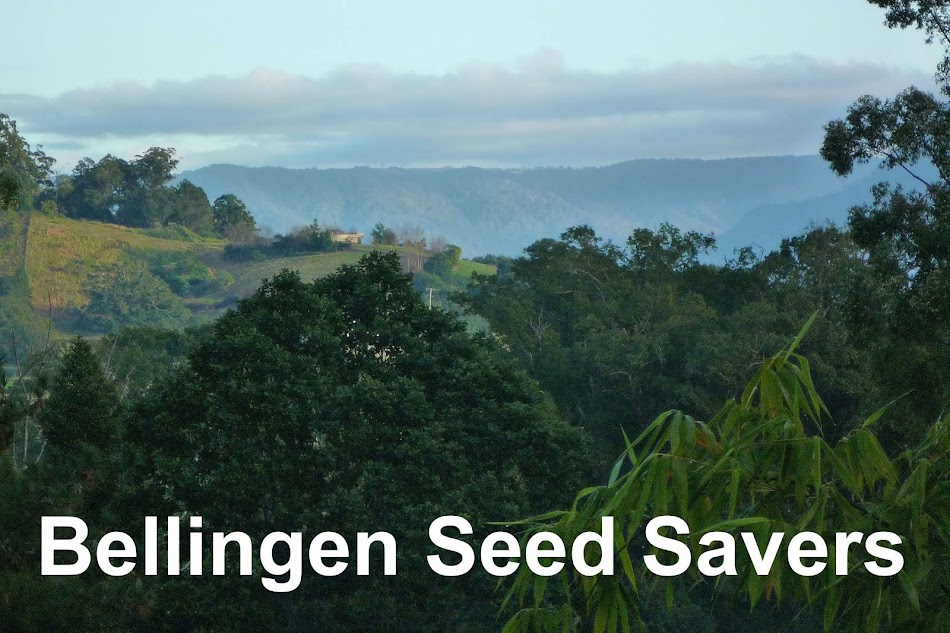It is mid spring in our November gardens. In this climate, on this north facing block, it is early summer. Click on any pic to enlarge.
The taro is in full leaf and grew throughout our mild winter.
Pink Brugmansia in front of Arundo Donax. The Arundo is useful as a source of mulch.
This Wax Jambu has just burst into flower. The fruit are crisp and moist.
A thorny Globe Artichoke has been left to flower but is delicious eating.
This Rose Apple was planted during winter under a wattle that will soon 'kick the bucket'. It has yet to start new growth.

A Tamarillo (
Solanum betaceum (
syn. Cyphomandra betacea) has already yielded a few fruit, its first crop. As yet Fruit Fly has not attacked this fruit and the plants are very productive in this Bellingen climate.
This Mangosteen was planted in autumn in a swampy part of a north facing slope. So far it likes its position but has not yet put on growth.
The choko vine is beginning to cover the poultry fence.
The White Mulberry has been fruiting for a few weeks. Birds have not yet recognised the ripe fruit (white to pale green) as ripe and have left the fruit for us. The flavour is extremely sweet and many prefer the black, common mulberry for taste.
Two
Burdekin Plum trees (Pleiogynium timorense)
are growing strongly. Native to Australia the fruit requires treatment to increase palatability.
Natal Plum (Carissa macrocarpa) is starting to flower for the first time. These plants were planted two years ago. The white flowers (like a small Gardenia flower) have a sweet smell. The plant is neat and very prickly.
This Fuju Persimmon is growing strongly again after dropping its leaves over winter.
A tropical peach looking quite miserable. Tip borer attacks this tree each year and prunes it. The Lomandra grass behind the tree is to edge the terrace.
Two Davidson Plums grow strongly.
An apricot has yet to flower despite its growth.
A Grumichama yielded a few fruit last year. They grow well in this climate.
This Longan tree finds the soil dry and poor despite its heavy mulch. The pine trees above it rob the soil of nutrients. Another location is required.
This Star Gooseberry (
Phyllanthus acidus), is also known as the
Otaheite gooseberry,
Malay gooseberry and
Tahitian gooseberry. It has the same name as
Sweetleaf, (Sauropus androgynus) which is confusing. This tropical plant has struggled with our mild winter and is only starting to regain its leaves. Perhaps it will last the next winter with leaves because of its growth. The Gota Kulu herb has almost swamped this plant.
Pecans grow strongly in this climate
This native lime bush produced many fruit last summer.
A young Rosella will need every warm day to produce its fruit. The fruit is excellent for jam making.
This 2.5m Black Sapote is growing strongly and may fruit this year.
A variety of edible figs survive this wet climate and produce fruit.
A Cavendish banana in fruit.
A Soursop regains its leaves after the winter defoliation and dieback that affects many tropical trees in our winter.
The Peanut Butter tree (Bunchosia) likes its warm wall and has produced a few fruit.
This Myrtus ugni is growing reasonably quickly but is yet to fruit.
The Mushroom plant is in flower.
Vetiver grass retains this steep slope and is also cut for mulch.
Day lily flower buds can be added to stirfries.
This yellow guava produces small, sweet fruit.
The variegated water parsley loves the edge of the pond and tastes like parsley.
The Kang Kong has survived the winter cold and is starting to grow across this pond.
I still find the leaves of this Brazilian Spinach very leather, but it is useful as a summer salad green.
This annual Amaranth does produce some mild tasting salad leaves.
Oca (Oxalis tuberosa) growing from a yam purchased from a local store in winter.
Close up of a Cape Gooseberry bush. If you look carefully you can see an immature fruit in its green casing (cape) which unfortunately do not protect the fruit from birds or Fruit Fly. Still this plant is extremely productive and delicious stewed with only a little sugar.
"Native to high-altitude, tropical Colombia, Chile, Ecuador and Peru, where the fruits grow wild, physalis is casually eaten and occasionally sold in markets." Wikipedia.
The Boysenberries are fruiting heavily. These plants were established in late summer last year and the boysenberries have swamped the Youngberry and Raspberry also growing on the trellis. So far the birds are leaving plenty for us.
This sharp thorned Kei Apple is yet to fruit. To persuade me tokeep these two plants (hopefully one male and one female) the fruit will need to be superb because this plant is an eye hazard.




















































